A Flood In The Garden….On Purpose
One of the most interesting things I encountered when I first moved to Arizona was driving down a residential street and seeing front yards full of 3 inches of water. Imagine my surprise when I learned that this was done on purpose to water the front and backyard.
Desert dwellers do like to do things differently so why shouldn’t that apply to how some of us water our landscapes? To view some ‘flooded’ landscapes, please join me for a visit to Double S Farms. Actually, Double S Farms is the home of my mother, my youngest sister & her family and they live only 5 minutes from me.
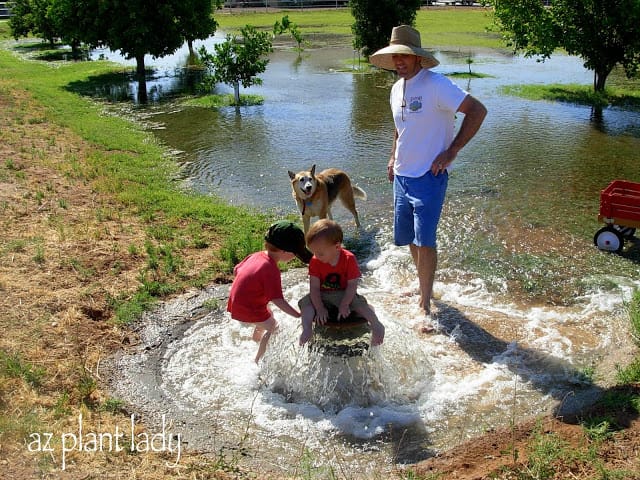
Farmer #1 and Little Farmers #1 & 2 (my nephews) opening up the flood irrigation valve.
Now, Double S Farms isn’t actually a typical farm. It is actually a home on 1 acre, which is called a ‘ranchette’ in our area because it is kind of like a little ranch. Double S Farms has citrus, plum, apple and peach trees as well as a vegetable garden. A chicken coop is currently going up and chickens will be moving in in a few weeks.
*We will be posting visits to Double S Farms in the near future, especially when the chickens move in and to show more cute pictures of Little Farmers #1 & 2.
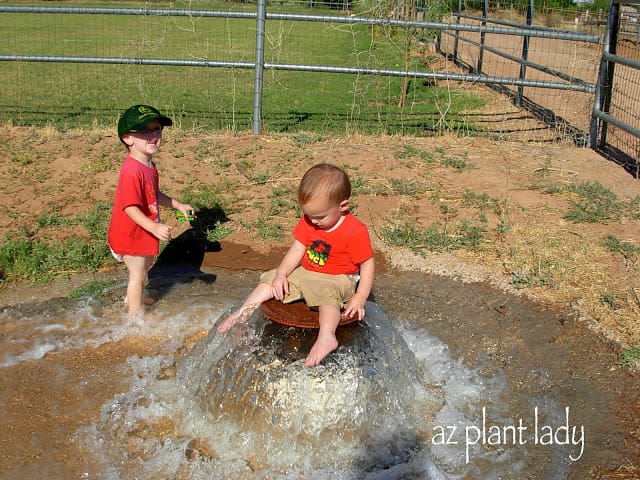
There is nothing more fun then cool water to play in in the middle of summer.
Okay, now back to irrigating – this type of irrigation, known as ‘flood irrigation’ is very inexpensive and therefore cost effective. Our first home in Phoenix had this type of irrigation back in the 1990’s and it only cost us $56 a year to irrigate both our front and backyard – my current garden uses drip irrigation and sprinklers.
Now not all homes in the Phoenix area are irrigated this way. Actually only a very few are and you have to live in certain areas where this is available.
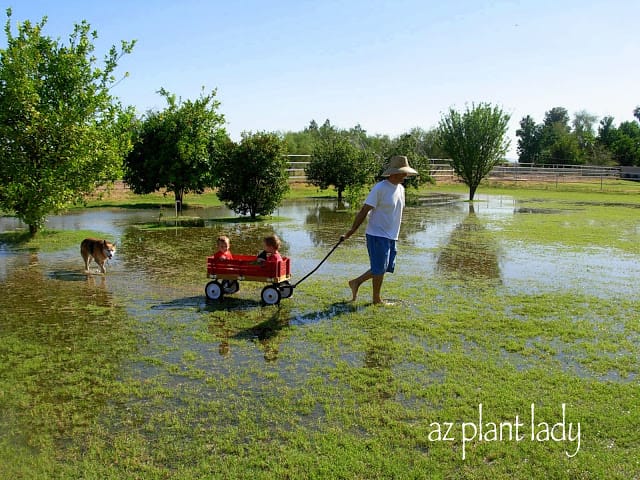
Addy, Little Farmers # 1 & 2 and Farmer #1 going inside after turning on the irrigation valve. In the background are their numerous citrus trees and an apple tree.
In the summertime flood irrigation occurs twice a month and in the winter time only once a month. Water sinks deeply into the soil which makes for deep roots for both grass and trees. It also helps to flush out salts that accumulate in the soil.
Okay, you may be wondering how the water gets from the mountains down into the yard. Well, the water comes from a series of reservoirs that collect water from snow melt and rain. Water users (homeowners) sign up each time that they want water and then only the amount needed is released from the reservoirs through the dams. This water then runs through one of seven major canals where a ‘zanjero’, (Spanish word for ‘water master’), opens a gate from the canal to allow water to flow into smaller lateral waterways that serve certain neighborhoods.
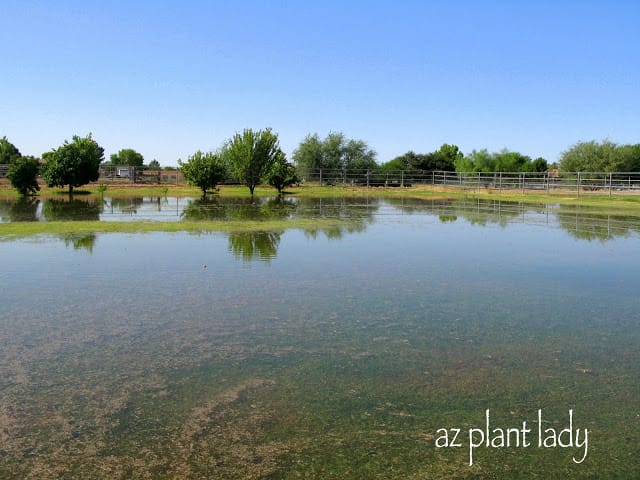
This is how deep the water is when the valve is turned off, about 2 – 3 inches deep. Behind their fence are cattle.
omeowners are told at exactly what day and time they can turn on & off the water. Each property has a certain allotment of water they can use.
I can tell you from experience that it is not fun when you have to get up in the middle of the night in January to open up the flood irrigation valve and then wait to turn it off. I have vivid memories of having to walk through freezing water to turn off the water in the middle of winter. However, nothing can beat how refreshing it is to irrigate during the summer months. Dogs and kids alike look forward to playing in the water.
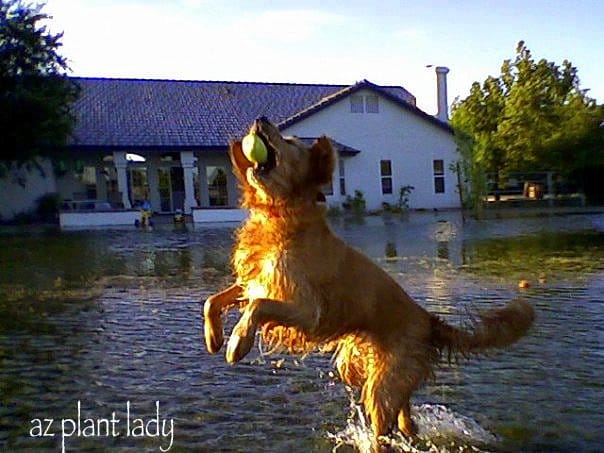
What could be more fun then playing fetch in the water? *Sodapop is the daughter of my dog, Missy.
Many of you were so kind to comment on my previous post “What Planet Have I Landed On?” and had a lot of questions regarding the photo I posted of flood irrigation. I hope this has answered some of your questions. If you would like to learn more, please click here .

 Noelle Johnson, aka, 'AZ Plant Lady' is a author, horticulturist, and landscape consultant who helps people learn how to create, grow, and maintain beautiful desert gardens that thrive in a hot, dry climate. She does this through her consulting services, her online class Desert Gardening 101, and her monthly membership club, Through the Garden Gate. As she likes to tell desert-dwellers, "Gardening in the desert isn't hard, but it is different."
Noelle Johnson, aka, 'AZ Plant Lady' is a author, horticulturist, and landscape consultant who helps people learn how to create, grow, and maintain beautiful desert gardens that thrive in a hot, dry climate. She does this through her consulting services, her online class Desert Gardening 101, and her monthly membership club, Through the Garden Gate. As she likes to tell desert-dwellers, "Gardening in the desert isn't hard, but it is different."
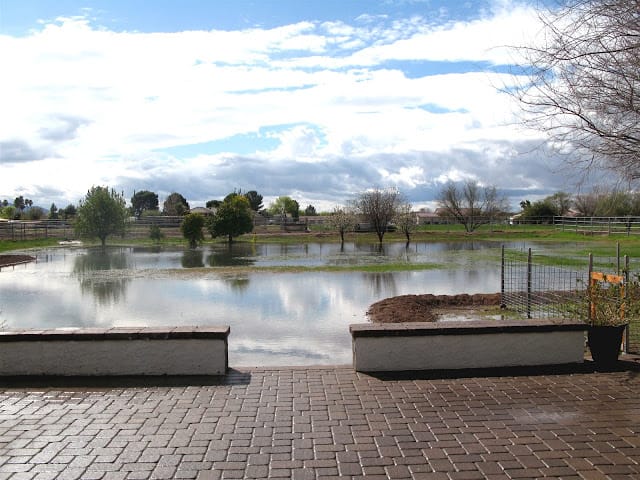






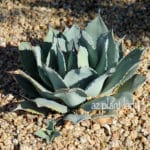

Noelle,
Thank you for such an interesting and informative post! I can imagine, as you said, that this type of irrigation could be inconvenient at times, but the look on those kids faces would make it all worth it.
By the way, I have fallen in love with yet another Agave after reading your last post – Agave desmettiana. I was excited to find a species that doesn't require quite as much sun. 🙂
Thanks for the explanation of this technique, Noelle. Flooding would seem the best way to get water to the deepest roots. Very cute farmers! 🙂
Frances
This is w-a-y cool! I am looking forward to seeing more of S&S Ranchette in the future.
Noelle thanks for the great info – I was one of those who was intrigued by that photo in your previous post. You have enlightened me tonight with this info – so interesting. Noelle in your last photo it shows the water pretty close to your house – does it ever touch the walls of the house?
Rosie 🙂
I had no idea! Very informative post.
This is my first visit. I have seen you often commenting on other gardeners' blogs and your title sparked my curiosity. I will visit again. Pamela
Oh, and your nephews are adorable.
There is a lot one can learn from what you write and its very interesting. Sounds like a very good solution in desert areas. And extremly odd to think about in the coldest part of the season. We are expecting -26 degrees celsius on Friday. But eventually sun-I shall be ready with the camera. Hope that the new year feels like a new year with new opportunities!
I never heard of flood irrigation – not something we practice here, at least not on purpose! This was a very interesting and informative post. The children and pets look like they are having a ball!
Great post!! Little farmer #1 & #2 are SO CUTE, are they twins? Flood irrigation was quite common here for some time, more with crops than with residential yards though. Farms are also on irrigation 'water rights' which is held in large reservoirs and travels via canals all over the countryside, and they book certain amounts for certain days. So different than areas where you can count on rain.
I look forward to future posts, I've always wanted a chicken coop, I think chickens are charming.
This was very interesting. My grandfather in Mexico used to grow all their food. And this in the very hot dry area of Caborca, Sonora. My mother says a flood would come maybe once or twice a year and that was basically it. He'd save the best seeds each year to replant. These were seeds that could survive that climate. Gloria
Noelle, I wasn't aware of that kind of irrigation in AZ although we have spent some time there in the past. I love those two little farmers!
It sure did answer my questions – thank you for your explanation!
That irrigation valve looks like a great place to sit when you want to cool off in the desert heat. I hope you had your turn, too! 🙂
This is really new to me! Thanks – very interesting.
Didn't know there is such thing as this.
In the eastern side of Malaysia, during Oct-Dec, most of the villagers face this during the monsoon season (just like the pic) and its often dreaded as the road and houses get flooded.
So much so, most houses are raised few meters above ground level.
Very informative. Thanks. so good to see those 2 boys enjoying themselves
Most interesting. I can't imagine the winter flooding…brrrr.
Very interesting post. I love the pictures!
Interesting….seems like it would use so much water….maybe in the long run it's more efficient?
Noelle~~ It looks like this type of irrigation brings out the kid in us. I keep thinking how fun it would be to go tromping through the water.
Who needs a pool? A front lawn will suffice. 🙂
Can't wait to see more about s and s farm.
Rosey
This is so interesting, Noelle! I remember seeing the canals when I visited Phoenix, but I had no idea that yards were flooded on purpose. I have noticed, though, that certain areas, like the one my daughter lives in, have lots of lush grass while others have dirt and rock around their homes.
Your little farmers are adorable–they must love it when the sprinklers are turned on. And what a great shot of Sodapop!
We have acequias here in NM, it's the best way to water.
I love that photo of your dog catching the ball, great!
I remember being shocked/surprised I first saw this after moving to Phoenix. My high school did this to the grounds every so often. It would literally create a (very) temporary sheet of water across the entire grassy area. I didn't understand all the details though, so thanks for the post.
Very interesting. And, it makes sense to water this way. Those roots need to be nice and deep in the desert areas.
Like Susie, I think it looks a lot of water. It is good that it is on the ground not sprayed into the air, which is sadly still what farmers do on their fields in South Africa. It will not be sustainable in the future?? There used to be leiwater on our plot, and the previous owner grew rice. But this town no longer has that sort of water to waste.
Great info for me to learn today! Thanks for the great explanation on irrigating in AZ. We lived in Colorado for a year and we noticed all the water reservoirs from the snow melts in the mountains. I can only wonder if they have some sort of irrigation such as this. Hum, You now have my mind a wondering…
Fascinating. I have to say that it looks wasteful, but perhaps the total volume is less than with sprinklers? Thanks for sharing the pics.
This is a great post Noelle. Even though this is my backyard, I learned something new =) Although flood irrigation can be a pain as you mention (waking up in the middle of the night), it has been an interesting experience for us.
I am certainly not an expert, but I think this is probably a better use of water for us here than daily use of a sprinkler system would be. However, we have to be very careful to only order the amount needed to avoid over watering and water run off. We only water twice a month in the summer and once a month in the winter and early spring months (with a 2 1/2 month break from watering altogether to clean the canals) so I imagine that we are actually using less water in a more efficient way. My husband was actually able to create a system so that the water funnels into the front yard as well so we no longer need sprinklers there either.
We order the same amount of water each time but the water pressure varies from watering to watering. The 4th picture down is about the average that we get. The picture with our dog Sodapop is definitely the exception – that is the one and only time the pressure has been so high to give us so much water (it actually made us a bit nervous). Noelle designed a fabulous landscape for us so the water does not actually go up to our walls.
We're still getting used to watering this way but as many of you have mentioned, little farmers 1 and 2 love to cool off with it in the summer and it brings out an abundance of cool critters (snakes, toads, ducks, geese, etc.) =)
Hello Everyone,
Thank you very much for your comments. I have had some comments asking if flood irrigation is wastes water in comparison to using sprinklers. My youngest sister has left a comment that goes into more detail and may answer some of your questions 🙂
This is so interesting! I did wonder about it from the earlier post you mentioned it on. I can only imagine having to get up on a cold winter night to irrigate.
Your posts are always so interesting, I really look forward to them.
Wow! I will ask my relatives in Phoenix if they know about such thing. Very interesting! Thank you! The pictures are great! Kids are having fun, and dogs to!
Very informative!! Wow! I love the term Zanjero! Can't wait to see the ranchette and it's new addition, the chicken coop!
I love learning unusual new things about different parts of the world. My guess is that this more or less mimics what happens with precipitation in a desert or near-desert environment — a dousing of heavy rain from time to time that floods the soil then percolates down deep. Wherever we live, anyone who waters should remember that occasional but deep watering grows far healthier plants than frequent, shallow "sprinkling."
I remember a co-worker of my husband, who grew up on a farm talking about when her dad flooded the fields to irrigate. She said they loved playing in the water. I've never heard of this kind of irrigation in a yard. I enjoyed your post!
Very interesting. We get flood irrigation too but it comes only when the weather gods schedule it…
I grew up with the irrigation canals in SoCal but never saw anything like this saturation approach.
Thanks for explaining it but I still think it is utterly and thoroughly bizarre.
Hi Noelle
I was fascinated by this post. Its a great idea. I suppose it only works in areas that are very level. Also, I guess you are not in drought to be able to use that much water on home gardens?
regards
Robyn
What an interesting way to water. I’ve never heard of such a thing.